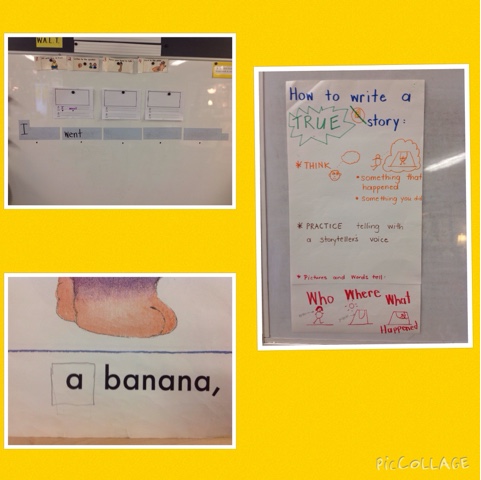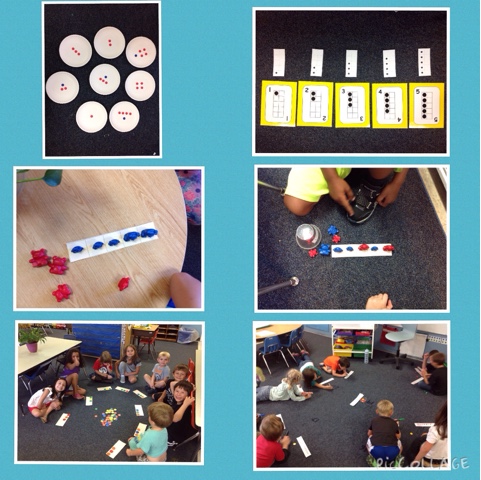One of our first "big ideas" in math this year was to notice how numbers are used in the real world and recognize what numbers tell us about ourselves and the world around us.
When young children see how numbers have a purpose in their everyday life they can begin to develop number sense.
Number sense refers to a child's ability to use and understand numbers by:
* knowing their value
* how to use numbers to make judgements
* how to use numbers flexibly when adding or subtracting
* having strategies for counting, measuring and estimating
To begin our year-long journey toward number sense we have focused on counting by ones to ten, recognizing those numerals, comparing them and ordering them in sequence. We are learning that numbers and their amounts can be represented in a variety of ways. When counting to answer "how many" the last number said tells the number of objects counted and the number of objects stays the same regardless of how they are arranged. When counting, the next number refers to an amount that is larger by one. These foundational skills fall within the domain known as Counting and Cardinality of the Common Core State Standards (CCSS) which we follow for mathematics instruction. We want children to know the number names and the counting sequence, along with counting to tell how many and how numbers and amounts can be compared.
We learned two useful counting strategies to help keep track of a group of counted objects. The first is what I call the "doorbell" strategy where one touches an object and pauses for a split second to finish saying the number name before moving to touch the next. This pause helps ensure children are touching each object counted in a one to one correspondence fashion. The second is the "pull away" strategy where one ensures they pull away the counted object from the group that is uncounted so that two distinct piles are made. You may see your child counting with these strategies a bit more dramatically as they have been introduced and you will see photos here of our practice.
To help us recognize amounts that match a numeral, we are using cards called "five frames" and “ten frames” throughout our day. The five frames helped us grasp a solid understanding of what one of my math instructors calls a sense of "fiveness." By knowing how five can be composed and decomposed, young children can use this as a building block for ten, twenty, and so forth. They can begin to apply what they know about five to larger numbers and use that other math computational skills.
Ten frames consist of a grid with two rows of five. The spaces can be filled in with dots or materials to represent a corresponding number. These grids help children recognize an amount that matches a number. We use several types of printed five and ten frames with dot patterns that help kids make a mental picture of an amount that matches a number. Once children are able to recognize dot patterns quickly, we can use them in a various mathematical ways, including for addition and subtraction.
For several days we have worked with partners to represent number amounts while remembering the social strategies for working with a partner and finding solutions to problems together. This is a great link to the social conflict resolutions activities we are doing throughout the day. In one photo here you will see children showing their collection of “five” while practicing social skills of listening in a group, keeping their eyes on their speaker and focusing with their brain on what the speaker is saying. Being able to listen to peers in a group is a skills we will practice all year, adding more steps as we go along.
I will keep sending home the Home Links that support our EverydayMath program. This homework will greatly support your child's learning in school. Once you have completed the activity, you can send it to school and I will check it, acknowledge your child’s work and send it back home. Thanks for partnering in your child’s education!
Learning to recognize the color and name of pattern block shapes.
Explaining out mathematical ideas using a document camera. Here children are explaining how a particular shape looks and comparing those observations to other shapes and real life objects.
Practicing the "doorbell" and "pull away" counting strategies.
Learning to recognize numbers, counting and matching amounts to numbers.
Showing ways to represent an amount of five... and recognizing how is can look different, yet be the same amount.
Taking five apart and counting to ensure how two smaller amounts can add up to five. We love singing and chanting a variety of counting songs and poems. Using the game, "spin a number" to identify numbers and count to match that number.
Partner games to strengthen our mathematical thinking as we explain our answers to partners: How many more needed to make ten with Race to Ten and Ten Frame Draw. Domino dot patterns help strengthen recognizing those patterns on dice which are used for many math games.
Fiveness: How can five be represented in dot patterns, addition number stories and on ten frames.
Learning to subitize: Subitizing is a skill we practice to help kids automatically recognize and amount, especially between 0-10.




















































